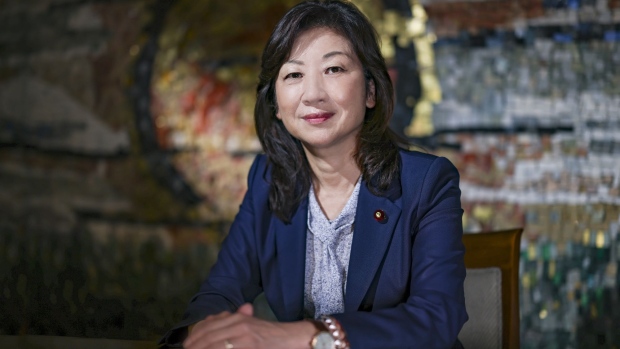Sep 28, 2021
Here Are the Contenders to Be Japan’s Next Prime Minister
, Bloomberg News

(Bloomberg) -- Japan’s ruling party picks a new leader Wednesday to replace outgoing Prime Minister Yoshihide Suga and guide the world’s third-largest economy as it tries to recover from the pandemic.
Candidates Fumio Kishida, Sanae Takaichi, Taro Kono and Seiko Noda are battling it out in what has been one of the most wide-open elections for leader of the ruling Liberal Democratic Party in about a decade. The LDP is expected to use its majority in parliament to elect the winner as the next prime minister at an extraordinary session on Oct. 4.
Markets believe the next leader will back a major stimulus plan, which has helped the Nikkei 225 surge almost 8% in September, the top performance among more than 90 global indexes tracked by Bloomberg. One of Suga’s final acts as premier has been setting an end for the virus emergency at the end of the month, which could provide another boost to the economy by easing restrictions limiting operations at eateries and other venues.
Japan to End Virus Emergency Nationwide This Week as Cases Fall
Apart from the economy, the new leader will also have to balance relations with the U.S., Japan’s sole treaty ally, and China, its biggest trading partner, as the two powers are at loggerheads on various issues.
Here’s a look at the top contenders:
Taro Kono, 58, administrative reform minister
A victory for Twitter-savvy Kono would elevate Japan’s czar for vaccine policy into a spot where he could push his calls to advance renewable energy and modernize antiquated systems that slow the wheels of bureaucracy. Kono has previously served as foreign and defense ministers and his fluency in English would be a stark contrast to Suga and almost every other Japanese premier who have shown limited proficiency in the language.
Kono has been the top choice among the public to be the next premier, which could help the LDP as it faces a national election just weeks after picking its new leader.
Policies:
- Stimulus package: Supports emergency spending, but has given no estimate on the amount, saying content more important than size
- Monetary: Inflation target of 2% difficult to hit. Growth spurs inflation, not the other way around. Previously called on the Bank of Japan to map out an exit from aggressive easing
- Energy: Partially backtracked on opposition to nuclear power, saying it’s realistic to restart nuclear plants if safety can be confirmed as a part of moves to achieve the country’s climate goals
- China: Concerned about Beijing’s rise and has said Japan should join the “Five Eyes” intelligence grouping among Australia, Canada, New Zealand, the U.K. and the U.S.
Fumio Kishida, 64, former foreign minister
A win for the self-effacing former banker Kishida, who quipped on the campaign trail about being considered boring, would put him in a position to steer the ruling conservative party slightly to the left and advance his plan to spend tens of trillions of yen to soften the economic fallout from the pandemic.
Kishida, who has campaigned to abolish nuclear weapons, has also served as foreign minister and leads his own liberal-leaning faction in the LDP. He played a key role in then-President Barack Obama’s 2016 trip to Hiroshima, where the U.S. leader pledged to pursue a world without atomic weapons.
Policies:
- Stimulus package: Says tens of trillions of yen must be spent immediately, without being more specific
- Monetary: Retains easing and the 2% inflation target
- Energy: Backs restarting idled nuclear reactors to help achieve net-zero carbon emissions goal by 2050
- China: Accused Beijing in a YouTube discussion this month of wanting to export “its authoritarian system around the world” and said Japan needed to stand up for “universal values.” Also has said Taiwan would be the “next big problem” facing the government
Sanae Takaichi, 60, former internal affairs minister
A victory for staunch conservative Takaichi, who has sought to stand out by brandishing her hawkish views on China, would mark the first time the country would be led by a woman and mark a sea-change in the male-dominated LDP. While Takaichi lacks the popularity of rivals Kishida and Kono, she enjoys the backing of her former boss, ex-Prime Minister Shinzo Abe and has pledged to support his priorities such as an ultra-loose monetary policy.
She has also been a regular visitor to Yasukuni Shrine in Tokyo, where 14 Class-A war criminals are enshrined along with other war dead and is seen by victims of Japan’s imperial army as a symbol of the country’s past militarism. Takaichi said she would continue visiting Yasukuni, even as premier -- which would almost certainly lead to a backlash from countries such as China and South Korea.
Policies:
- Stimulus package: Supports nimble, decisive spending during a crisis, without giving a figure. Considers extra bond issuance fine
- Monetary: Prioritizes the 2% inflation target over primary budget balance
- Energy: In favor of nuclear power and concerned about the problems of solar power, such as the difficulty of recycling panels
- China: Backs having the U.S. bring intermediate-range missiles to its U.S. bases in Japan, despite Beijing having said any country accepting such a deployment would face retaliation
Seiko Noda, 61, former internal affairs minister
Noda is also trying to be the first women elected leader of the LDP, but she was a late comer to the race and polling numbers from within the party indicate she has almost no chance of winning. The former internal affairs minister has said her policy priorities center on care for the vulnerable such as children and people with disabilities.
Policies:
- Wants to provide a flat-rate handout to all working people
- Favors cutting the number of seats in parliament
- Supports Taiwan’s entry into the Comprehensive and Progressive Agreement for Trans-Pacific Partnership
©2021 Bloomberg L.P.


